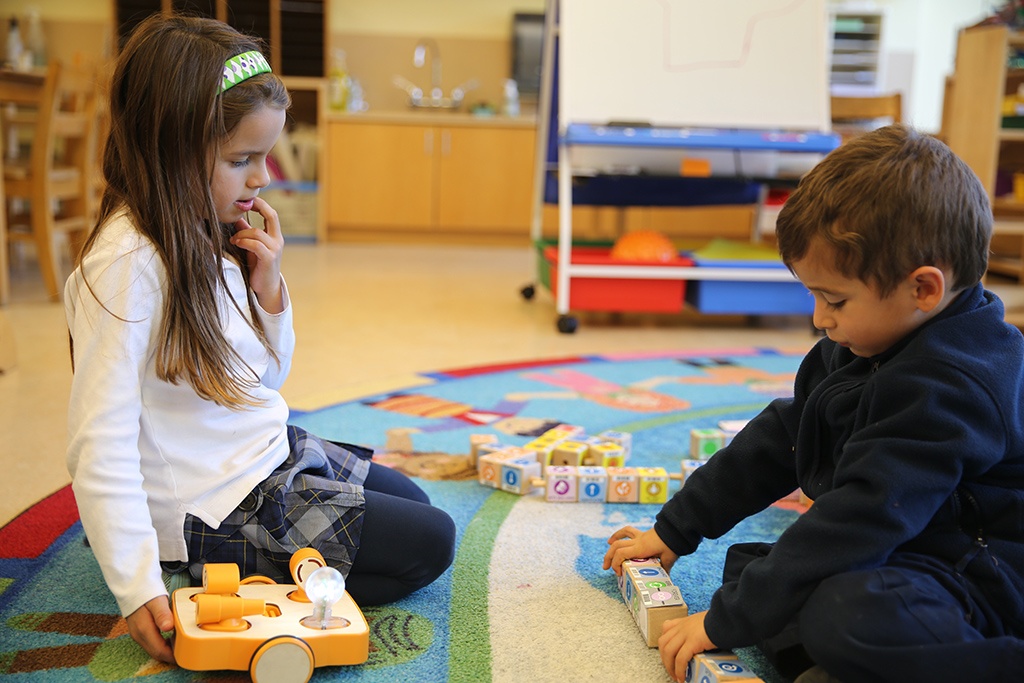During the summer of 2014, Whitby funded KIBO, a robot kit made for young children designed to teach programming and engineering on Kickstarter. KIBO was developed by KinderLab robotics at Tufts University after many years of research, and several prototypes.
We received our kits in January of 2015 and I introduced KIBO robots to the classroom shortly thereafter. It was a new technology—which alone is a dime a dozen—but what interested me is that it was robotics for kids that didn't use a computer, tablet or any kind of screen.
KIBO changes the way we think about technology in the classroom
Programming with KIBO is kid-friendly and appeals to children. What sets KIBO apart from every other programming environment is that it provides a tangible interface for interacting with and programming the robot. Rather than program KIBO through a computer, children must scan wooden blocks, which tell the robot what to do. This spoke to me because I believe that children learn from doing.

Though KIBO is still fairly new, its core concept comes from a programming language called LOGO, created more than 50 years ago by Seymour Papert. Papert was heavily influenced by the work of Jean Piaget, a pioneer in child development. Piaget who is quoted as saying "Education, for most people, means trying to lead the child to resemble the typical adult of his society ... but for me and no one else, education means making creators... You have to make inventors, innovators—not conformists."
LOGO featured a robot called Turtle. With simple instructions, users could tell Turtle what to do. For instance, to make Turtle go forward, users would simply type in the direction "FORWARD" followed by the amount of steps Turtle should take. The language and implementation of Turtle was designed for learning and KIBO is essentially the twenty-first century version of that, combining a timeless idea with a more modern presentation.
To get KIBO to do exactly what they want it to, students must scan the blocks in the order they want KIBO to perform the desired actions. Once presented with the KIBO, children learn to program the robot through play and collaborative inquiry. Once they get a hang of scanning the programming blocks, they can experiment to get the result they want. For the robot to do what the child wants, he or she must break the problem into the smallest possible steps. Programming the KIBO teaches sequencing, cause and effect, and programming concepts like feedback, loops and conditional logic.
Navigating technology in the classroom can be tricky because while its positive effects on education must be acknowledged, computer screens can often be a distraction. With this robot, kids play, design and iterate through their designs. I was also attracted to KIBO because it appealed to children who are technically minded as well as those who are more artistic.
"Why do we want four and five year olds to learn how to program?" she asks. "The same [reason] that we teach young children to learn how to read and write because we believe it's important, it offers new ways to think about the world and new ways to express yourself."
The robot has a customizable art platform which allows children to design their robot. They can make their robot into anything imaginable. It could be a character, car, fairy, elephant, superhero, etc. Children use KIBO’s wooden blocks to create their program and make the robot come to life by programming its behaviors.
In a TED Talk given in 2014 cofounder Marina Bers says that technology can have positive outcomes not just for technical skills, but also for a child’s social and emotional development.
"Why do we want four and five year olds to learn how to program?" she asks. "The same [reason] that we teach young children to learn how to read and write because we believe it's important, it offers new ways to think about the world and new ways to express yourself."
I see this with my own students all the time. Working with the KIBO kit in a classroom environment, children learn how to share and collaborate. And when they achieve the goals they set for themselves while they play, they build confidence and creativity one scan and one KIBO sequence at a time.


